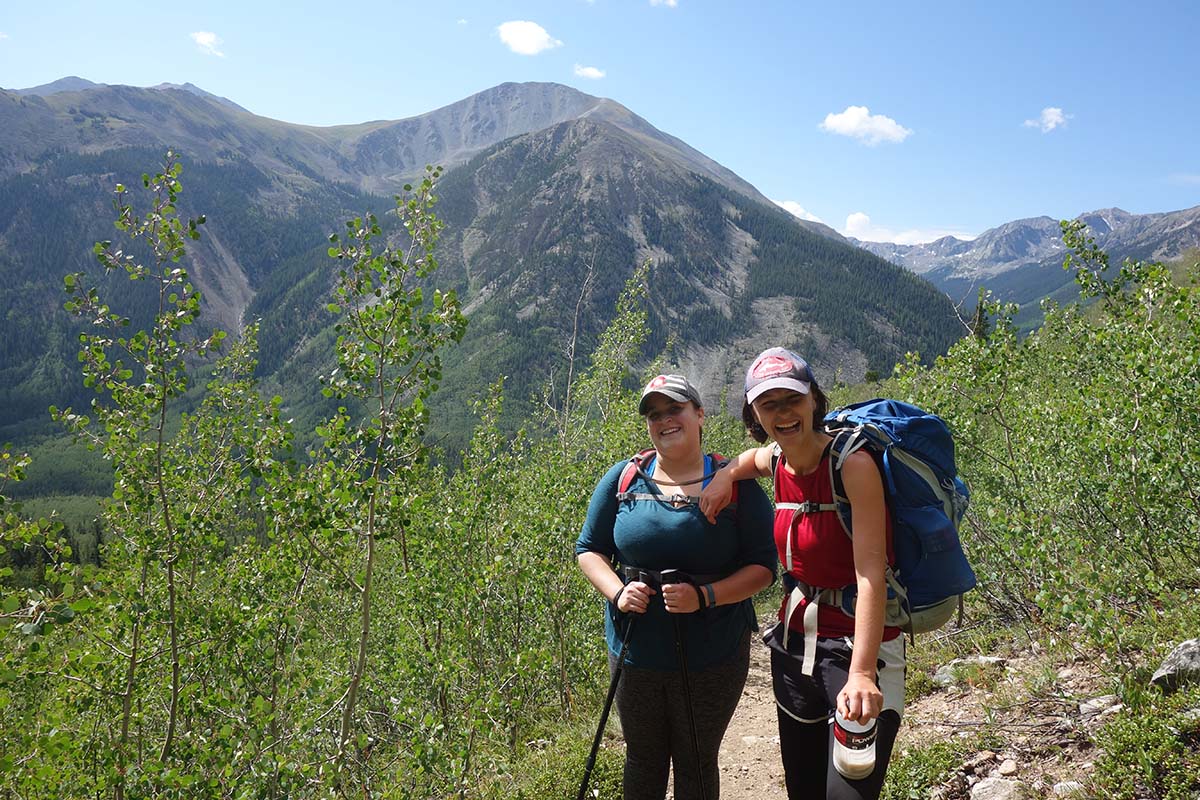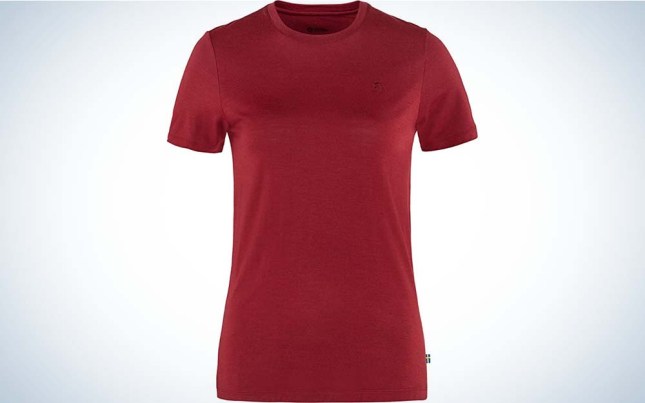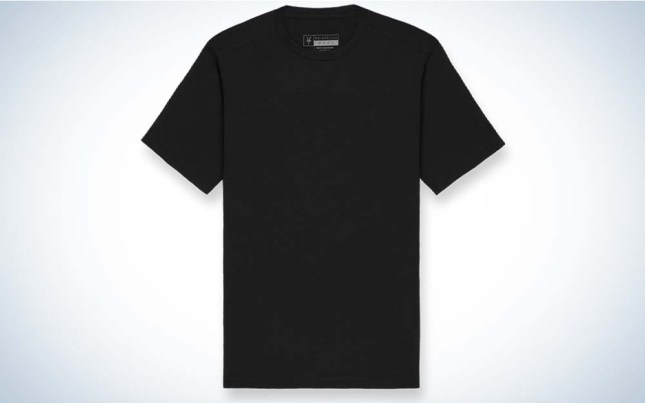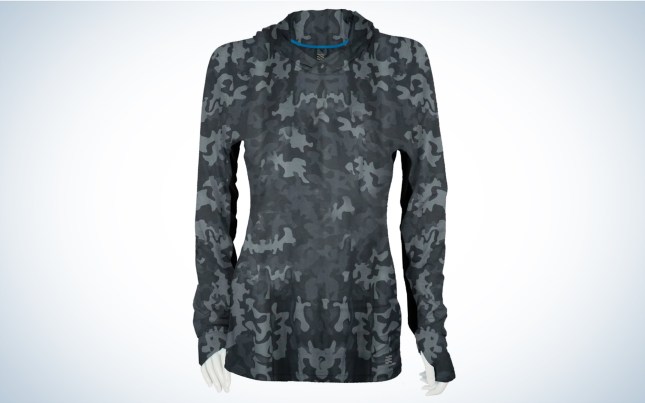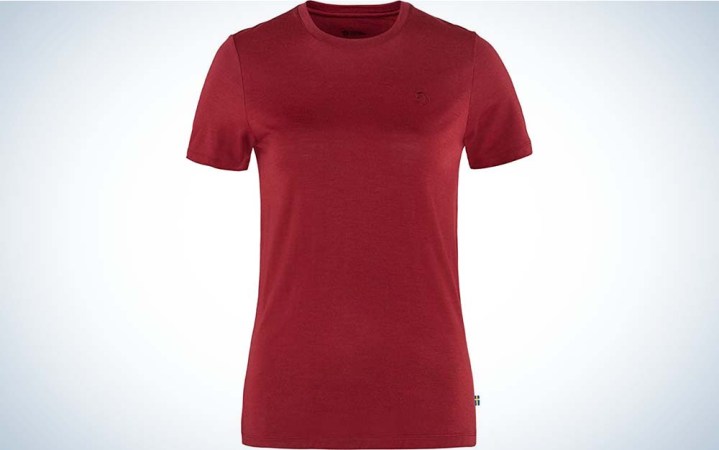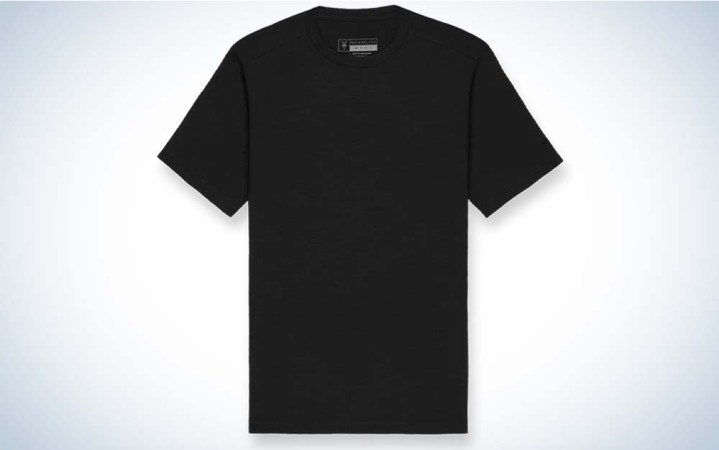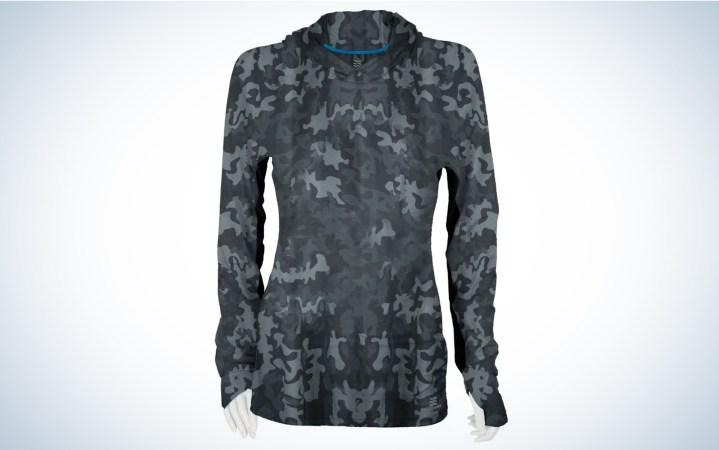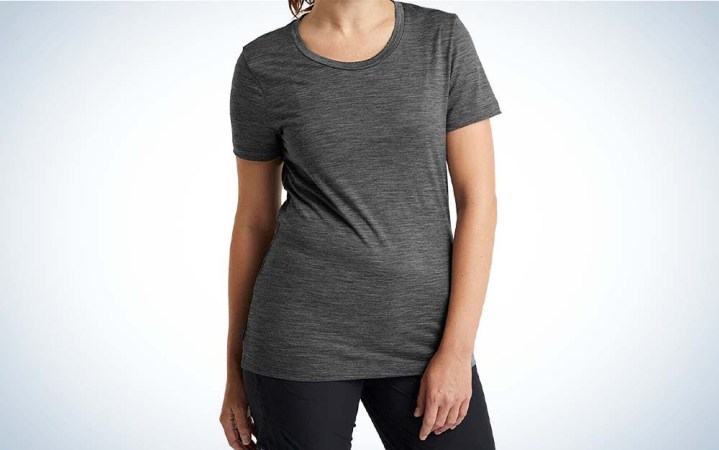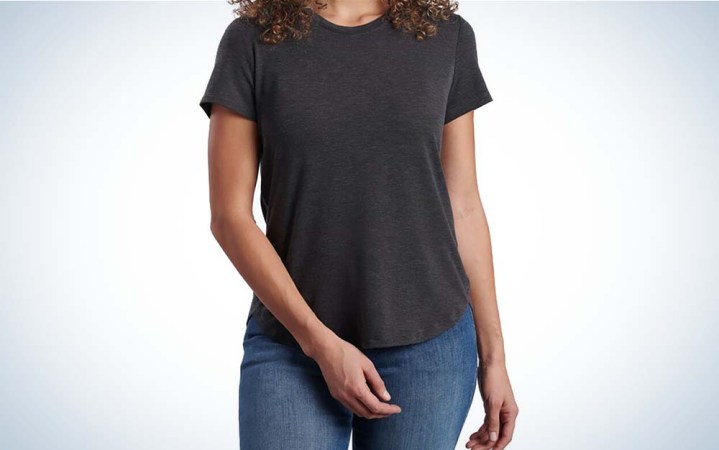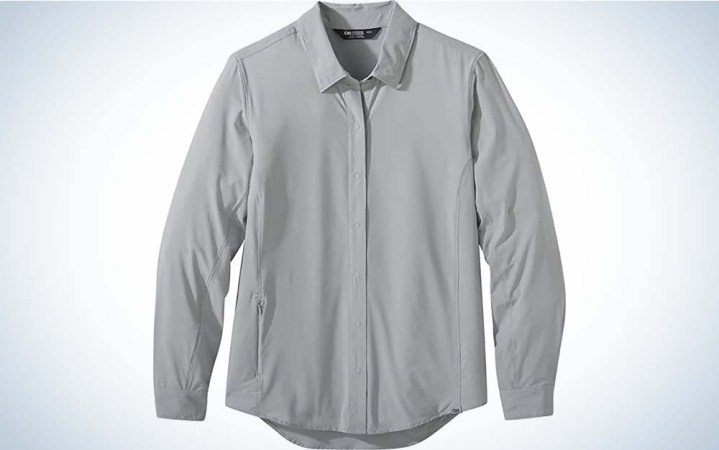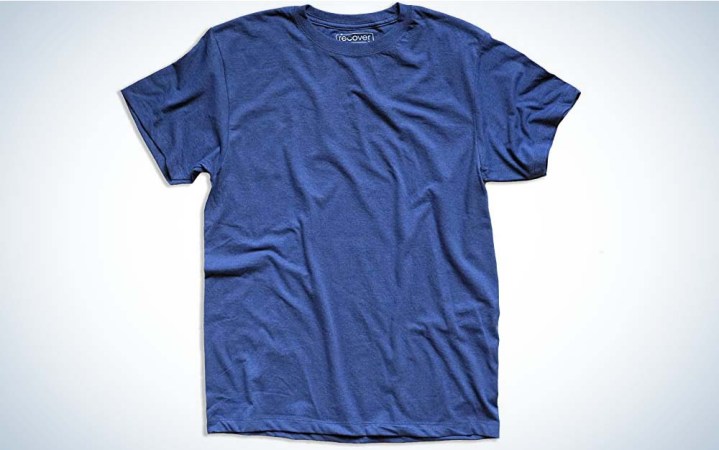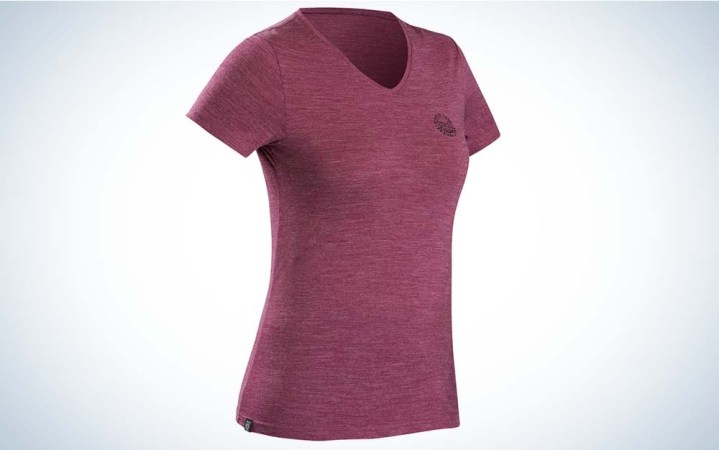We may earn revenue from the products available on this page and participate in affiliate programs. Learn More ›
When I first started hiking and backpacking on my own, I didn’t think much about my choice of hiking shirt. As long as it wasn’t made of cotton, I figured it would work in a pinch. Then I hiked the 2,600-mile Pacific Crest Trail. Over five months (and only three shirts), I learned the hard way about all the things that can go wrong with a hiking shirt: back blisters, shredded shoulders, clammy skin, and the smell—oh, the smell. To save you from a similar fate, I leveraged that experience to put ten tops through testing to find the best hiking shirts available today.
- Best Overall: Fjallraven Abisko Wool Short-Sleeve
- Fastest Drying: Ibex Journey Tee
- Best Cooling: FieldSheer Mobile Cooling Hooded Long Sleeve
- Best All Merino: Icebreaker Merino Tech Lite II Short Sleeve
- Best Synthetic: KÜHL Konstance Short Sleeve
- Best Sun Protection: Outdoor Research Women’s Astroman Long Sleeve Sun Shirt
- Best Eco-friendly: Recover Sports Tee
- Best Budget: Decathlon Forclaz Merino Wool T-Shirt
How I Tested the Best Hiking Shirts
After spending hundreds of days on the trail, I’ve developed a good understanding of what makes for the best hiking shirts and how to evaluate them in closed conditions, which provides for a more accurate comparison. For this test, I started by considering the different fibers used in the composition of the shirt, and how the composition would affect the durability, moisture management, and odor control of the shirt.
After that, I compared the skin feel of each shirt for comfort, and checked the fabric after washing for signs of wear or distress in the stitching, as well as pilling. Next, I compared these shirts’ ability to dry in a hot arid environment by soaking them in the tub, and then turning on a dehumidifier. Temps in the room reached upwards of eighty degrees with humidity levels below 30 percent. Finally, I wore these shirts out in the field in a number of different environments, from day hikes to camping trips to the Outdoor Life gear team’s turkey hunt.
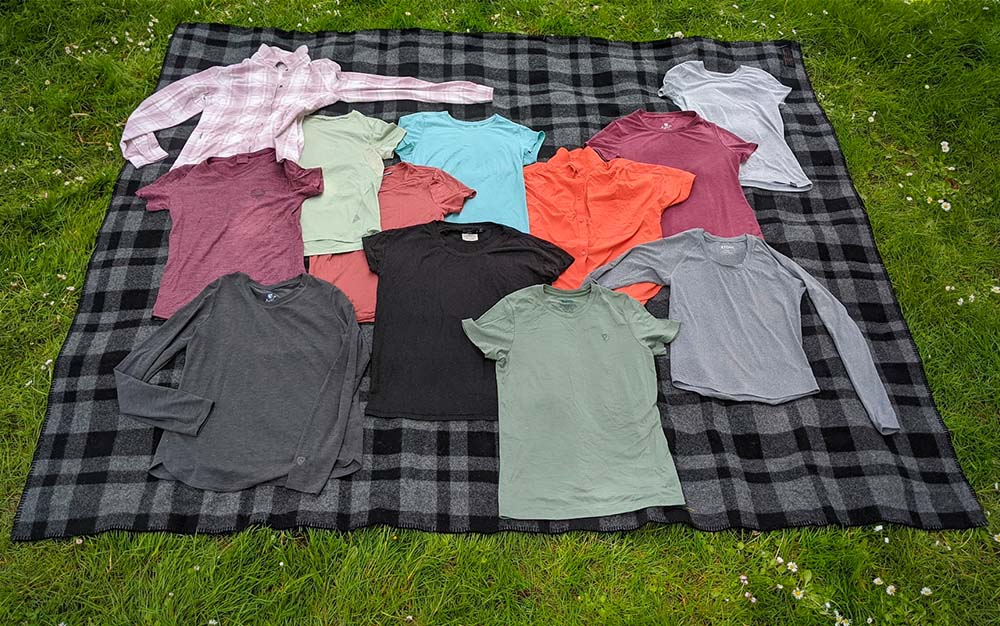
A few shirts in my test, ultimately, didn’t make the cut. While I was impressed with how the Decathlon Quechua MH 100’s used different fibers (polyamide) at the armpits to reduce odor retention, as well as its low price point, it felt more constrictive than other shirts in my test, and the mesh was somewhat irritating to more sensitive parts of my skin. The Stoic Tech Long-Sleeve T-Shirt, while at a similarly affordable price point, took quite a while to dry, was constrictive to move in, and offered only a limited range of sizes. I was excited about the high hemp content in the prAna Cozy Up Tee Shirt, but ultimately the thick knit and loose cut of the fabric made it neither an ideal choice for hot temperatures nor cool ones.
Best Hiking Shirts: Reviews & Recommendations
Best Overall: Fjallraven Abisko Wool Short-Sleeve
Key Features
- Materials: 50 percent wool and 50 percent polyester
- Sizing: XXS to XXL
- Available in short sleeve and long sleeve
- Available in men’s and women’s
Pros
- Sufficient merino content blocks odor build-up
- Comfortable skin feel
Cons
- Slightly thicker knit placed in the middle of my drying test
Like the best hiking shoes or boots, finding that one perfect hiking shirt can be a challenge. On the one side, there’s the synthetic options, which are generally affordable and great at wicking away moisture on hot days. But they can build up a stink, especially over time and tend to hold onto the body’s natural oils, which can make them less pleasant to put on at day five of a backpacking trip. Merino wool shirts, on the other hand, are scratchy compared to synthetic shirts, and get pretty pricey.
Of all the shirts I tested, the Fjallraven Abisko did the best job of marrying the performance of merino with the comfort and cost-savings of synthetics. Its half-and-half split meant that it was comfortable to put on the first time I tried it, and that it was also still comfortable to wear over three days of consecutive use. One thing to note about this shirt is that it is a slightly thicker knit than either my fastest-drying and best all-wool picks, and thus takes longer to dry out.
Fastest Drying: Ibex Journey Tee
Key Features
- Materials: 89 percent wool, 11 percent nylon
- Sizing: XS to XL
- Styles include short sleeve and long sleeve
- Available in men’s and women’s
Pros
- Fast drying
- High merino content provides wicking and odor control
- Nylon boost adds durability
Cons
- Expensive
- Less comfortable than other shirts in my test
The lightweight Ibex Journey Tee, which dried out faster than anything else in my test, balances the benefits of merino with the durability of nylon. There are all kinds of reasons your shirt ends up wet on a hike—sweat, rain, impromptu laundry. But wearing a wet shirt can also lead to a number of problems, including difficulty regulating temperatures. So when the Ibex Journey Tee dried out faster than any other in my test, I knew it was a winner.
While this shirt does incorporate nylon, it does so in a slightly unusual way. Instead of interweaving nylon and merino wool fibers, Ibex placed the nylon at the center of each individual fiber, and then encased it in merino. While placing the nylon at the center of each fiber should help to maximize the overall durability of the shirt, it does mean that this shirt does not benefit from the silky smooth feel of nylon, and instead feels like a more traditional wool shirt. (A best-in-class wool shirt, but still a wool shirt.)
Best Cooling: Fieldsheer Mobile Cooling Hooded Long Sleeve
Best Cooling
Fieldsheer Mobile Cooling Hooded Long Sleeve
Key Features
- Materials: 92 percent recycled polyester and 8 percent spandex
- Sizing: XS to XL
- Styles include hooded and not hooded
- Available in men’s and women’s
Pros
- Mineral infused fabric is moisture-wicking and breathable
- UPF 50
- Comfortable thumb holes
Cons
- Not the best choice for chilly conditions
- Holds onto odors
These shirts are made of a mineral-infused recycled fabric that dries fast and feels breathable. The sides and back are also ventilated for increased comfort in hot climates. The water absorbing and conductive minerals use your body’s heat to evaporate sweat and moisture while pulling heat away. The hood and thumb hole sleeve openings increase sun protection as the entire shirt is UPF 50. The hood sits comfortably with enough room for hat underneath and the thumb holes extend the shirt over my hands to avoid a sunburn. The skin feel and comfort of both the hooded long sleeve and not hooded long sleeve are great.
While they both feature odor control technology, these shirts hold onto odor more than a merino or bamboo fabric does. While you could wear this shirt year-round, because it is so breathable, I’d only recommend it in hot weather. If you put it under a jacket, you may as well only be wearing the jacket. However in high heat scenarios, this cooling shirt can’t be beat.
Best All Merino: Icebreaker Merino Tech Lite II Short Sleeve
Key Features
- Materials: 100 percent wool
- Sizing: XS to XL
- Styles include scoop neck and long sleeves
- Available in men’s and women’s
Pros
- Fantastic odor control
- Excellent temperature regulation
- Good wicking
Cons
- Not as soft as other shirts in our test
- Expensive
You can go days without washing and this all-wool shirt and still feel good to put it on in the morning. If I’m heading out into the backcountry, where the only “laundry” I’ll be doing is dunking my layers in a stream during the heat of midday, there is only one fiber I want against my skin: merino wool. Whereas synthetic fibers start to feel clammy and sweaty by the end of the second day—if you’re lucky—I’ve gone up to nine days without washing a merino wool top and was still completely happy to put it on in the morning. You can’t have too much merino wool in an article of clothing in my books, and this shirt from Icebreaker agrees. It’s 100 percent merino wool.
Of course, there are some trade-offs here. This shirt wasn’t as soft as many of the synthetic shirts in my test at first glance. It also held onto moisture longer than expected during the drying test (wool is hydrophilic, after all). Finally, it’s plenty expensive. But for sheer comfort, this one is worth the price.
Best Synthetic: KÜHL Konstance Short Sleeve
Key Features
- Materials: 84 percent polyester, 11 percent Tencel, 5 percent spandex
- Sizing: XS to XL
- Styles include short sleeve and long sleeve
- Available in women’s only
Pros
- Comfortable
- Affordable
- A good choice for someone with a wool allergy
Cons
- Holds onto smells longer than wool shirts
The KÜHL Konstance balances comfort and performance with a blend of three different synthetic fibers. The trouble with merino wool is that it’s pricey—shirts with a high merino content can be as much as twice the price as their synthetic counterparts. And while most people find merino wool shirts significantly less scratchy than more traditional wool products, they still contain lanolin and can trigger a reaction for anyone with a wool allergy.
The KÜHL Konstance was one of the most comfortable shirts in my test. Where other synthetic shirts feel cold and clammy when you start to sweat (especially in the cool, wet days of spring), this top has a great skin feel. This results from its unusual fabric blend, which combines a high amount of polyester (this shirt came out in the middle of the pack in the drying test) with a touch of Tencel, a fiber made from wood pulp that is soft and most often seen in bed sheets. A small amount of spandex also added a touch of stretch that maximized my range of movement.
Best Sun Protection: Outdoor Research Women’s Astroman Long Sleeve Sun Shirt
Key Features
- Materials: 85 percent nylon and 15 percent spandex
- Sizing: XS to XXL
- Styles include long and short sleeves
- Available in men’s and women’s
Pros
- UPF 50 and long sleeves protect your skin from the sun
- Fast drying (came in third in my test)
- Loose fit allows air to circulate next to your body
Cons
- Not the best choice for shoulder season conditions or alpine hikes
- Strange zip pocket placement at the side waist
- Holds onto unwanted odors over time
The loose fit and UPF protection of the Outdoor Research Astroman series is the perfect fit for scorching summer days. Most hiking shirts have a close fit that helps maximize the wicking ability of the fabric: the sooner your sweat hits the fabric, the sooner it’s pushed to the outside air to evaporate. If you’re hiking somewhere where conditions are variable—either because the weather can change in a hurry or you are hiking up a mountainside—this is what you want. In addition to evaporation helping your body cool off when it’s hot, staying dry means you won’t get chilled when the temps cool back down. But sometimes you know it’s not going to cool back down again—even at night. For those days, temperature regulation and moisture management isn’t the goal. It’s just to stay cool.
That’s where the loose fit of the Outdoor Research Astroman series comes in. It allows air to circulate underneath the clothing itself, so that your sweat will tend to evaporate closer to your skin, keeping you cooler overall. It also utilizes nylon fibers, rather than wool, which are better at providing protection from the UV rays of the sun.
Best Eco-Friendly: Recover Sports Tee
Key Features
- Materials: 100 percent recycled polyester
- Sizing: XS to XL
- Styles include V-neck, tank top, and long sleeve
- Available in women’s and men’s
Pros
- Made from recycled water bottles
- Comfortable material
- Great durability for the price point
Cons
- One of the longest-drying shirts in my test
- Constrictive fit around the arms
Most apparel companies are happy to advertise using any percentage of recycled material in their outdoor collections, but Recover pushes the envelope by using 100 percent recycled materials in their Sport Collection. I was impressed with the comfortable skin feel of the Sports Tee, even after two consecutive days of wearing it without washing. While it utilizes a tight knit that appears quite durable, during testing the Recover Sports Tee was one of the slowest shirts to dry. It was also prone to holding onto odors (the main reason why I didn’t continue wearing it after two days without washing).
Best Budget: Decathlon Forclaz Merino Wool T-Shirt
Key Features
- Materials: 70 percent merino wool, 30 percent acrylic
- Sizing: XS to XL
- One style only
- Available in women’s only
Pros
- Affordable
- Quick drying
- High proportion of merino wool
Cons
- Itchier than other merino wool shirts in my test
- No other cuts available and not available in men’s
The thing about merino wool hiking shirts is that they eventually wear out, usually after one hard season of use. That can make it hard to justify the associated price tag. But the Decathlon Forclaz Merino Wool T-Shirt has a high merino content (70 percent) at a low cost—the only real tradeoff off here is that the larger fibers used (19 microns) mean that this shirt is not as soft as others in my test, which were closer to 17 microns. If you have sensitive skin and expect to work up a sweat, this shirt may not be the right choice for you. Acrylic, the other 30 percent of the shirt’s content, provides a durability boost without compromising (or adding much to) the wicking ability of merino.
Things to Consider Before Buying the Best Hiking Shirt
Hiking shirts can be made out of a number of different fibers, including polyester, nylon, hemp, Tencel, wool, and spandex. While most hiking shirts combine two or more of these to maximize the different properties of each fiber, some are made exclusively from a single material. Here’s a quick rundown of the different qualities of each fiber, and why they are used in hiking shirts:
Polyester
This is the workhorse fiber of outdoor apparel. It wicks great, breathes well, it’s comfortable, and it’s cheap. Polyester’s downfall is with long-term use. Since it tends to hold onto the body’s oils better than other fibers, odors build up over time and become permanent (even with washing). These oils can also make the fabric feel cold and clammy against your skin.
Acrylic
Acrylic is similar to polyester except it doesn’t breathe as well and tends to hold onto heat.
Nylon
Nylon (sometimes called polyamide) is tough, adding durability to outdoor clothing. It does not wick as well as polyester or wool, but it holds onto fewer odors than polyester (although it’s not as good at odor prevention as wool). Clothing made entirely out of nylon may create more static than those made from other fibers.
Wool
Wool, typically merino wool, is known for its wicking ability, especially in the best thermal underwear—the semi-hollow fibers retain heat, which help to draw in moisture from the body and push it to the exterior of your shirt where it can evaporate faster. Wool also contains lanolin, which helps to prevent body odors from accumulating. It is not especially durable, and tends to be more expensive than synthetics.
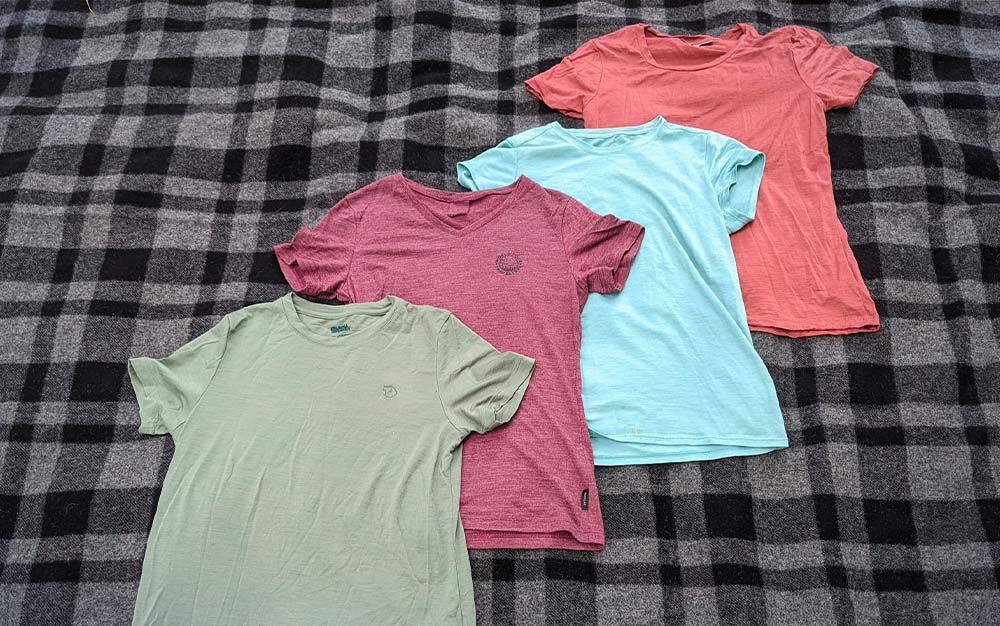
Hemp
Hemp is an increasingly popular fiber in outdoor clothing. While it tends to hold onto moisture longer than other technical fibers, grooves along the fibers allow it to wick moisture away from the body. It also has some antibacterial properties (the plant has to protect itself, after all) that can reduce odor build-up but is typically more affordable than wool.
Rayon
This is usually only seen in outdoor clothing in small quantities, often under the brand name Tencel. This fiber is extremely comfortable, but doesn’t have the same performance properties as polyester, nylon, or wool.
Elastane
Also called spandex, these fibers add stretch to outdoor clothing, which can be useful if you’re looking for a close fit.
One fiber that’s virtually never seen in hiking shirts is cotton, as cotton is notorious for holding onto moisture and chaffing.
FAQs
Hiking shirts range in cost from $10 to $90, depending on the materials used.
Whether or not a hiking shirt should be worn tight or loose is mainly an issue of personal preference, but different conditions can make one or the other more appealing. In exceptionally hot and dry conditions, a loose fit allows cool air to circulate under the fabric. However, a tighter fit works better for cool but humid conditions, where the heat of your body can generate sweat underneath several layers of clothing. In those instances, a closer fit will help move sweat away from the body faster.
The number of layers you should wear during hiking varies between one and four, depending on the conditions. In hot weather, a single layer—your hiking shirt—is more than sufficient. In cold weather, you can either wear your hiking shirt as a base layer, as they function similarly, or swap in something that is a heavier weight. Either way, the best base layers will provide some warmth and keep your skin dry. On top of that, add a puffer layer, which will provide the majority of your warmth. If it’s raining, or exceptionally windy, add a raincoat—your fourth layer. If it’s extremely cold, a heavyweight fleece layer between your puffer layers and midweight base layer can help you retain even more heat.
Why Trust Outdoor Life?
Since 1898, OL has been a leading authority in testing and reviewing hunting gear, fishing tackle, guns and shooting equipment, and much more. We have more than a century-long history of evaluating products, and we’re now bringing that expertise to online reviews. Our editors are experienced outdoorsmen and women, and most importantly, we’re trained journalists. We prioritize field testing and objective data when reviewing products. We conduct interviews with gear manufacturers and engineers as well as outdoor experts so that our readers have an understanding of how and why a product works—or doesn’t.
Advertising does not influence our gear reviews and it never will. While we always focus our coverage on standout products—because we want our readers to be aware of the latest and greatest gear—we also cover the flaws and quirks of any given product.
Final Thoughts
After putting the best hiking shirts through their paces, I determined that the Fjallraven Abisko was the best available today. The Ibex Journey Tee is also a great choice for anyone who doesn’t mind the feel of merino wool and is willing to spend a little extra on their hiking apparel. Figure out what material feels most comfortable and works for you, then get hiking.
- Best Overall: Fjallraven Abisko Wool Short-Sleeve
- Fastest Drying: Ibex Journey Tee
- Best Cooling: FieldSheer Mobile Cooling Hooded Long Sleeve
- Best All Merino: Icebreaker Merino Tech Lite II Short Sleeve
- Best Synthetic: KÜHL Konstance Short Sleeve
- Best Sun Protection: Outdoor Research Women’s Astroman Long Sleeve Sun Shirt
- Best Eco-friendly: Recover Sports Tee
- Best Budget: Decathlon Forclaz Merino Wool T-Shirt
